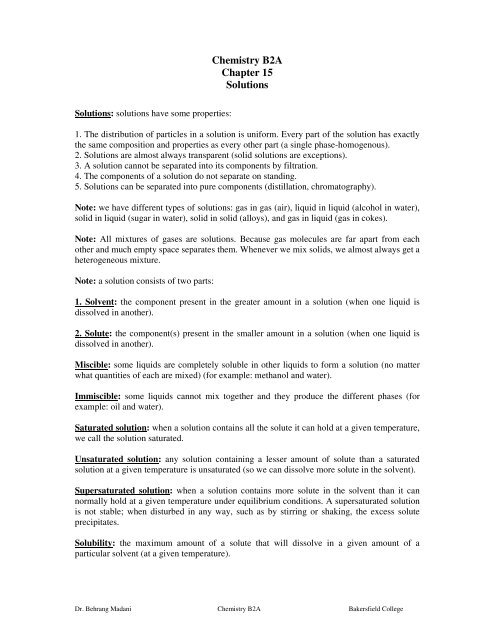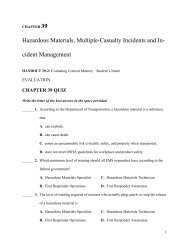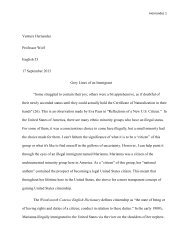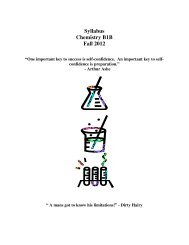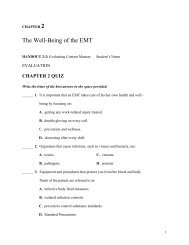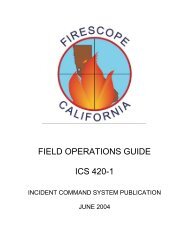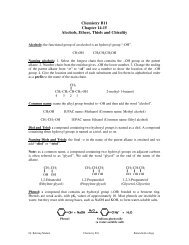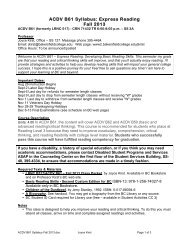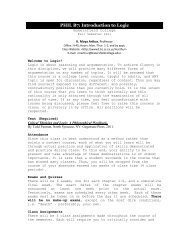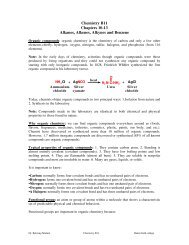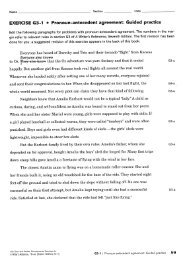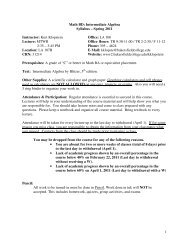Lecture notes Chapter 15 - Bakersfield College
Lecture notes Chapter 15 - Bakersfield College
Lecture notes Chapter 15 - Bakersfield College
Create successful ePaper yourself
Turn your PDF publications into a flip-book with our unique Google optimized e-Paper software.
Chemistry B2A<br />
<strong>Chapter</strong> <strong>15</strong><br />
Solutions<br />
Solutions: solutions have some properties:<br />
1. The distribution of particles in a solution is uniform. Every part of the solution has exactly<br />
the same composition and properties as every other part (a single phase-homogenous).<br />
2. Solutions are almost always transparent (solid solutions are exceptions).<br />
3. A solution cannot be separated into its components by filtration.<br />
4. The components of a solution do not separate on standing.<br />
5. Solutions can be separated into pure components (distillation, chromatography).<br />
Note: we have different types of solutions: gas in gas (air), liquid in liquid (alcohol in water),<br />
solid in liquid (sugar in water), solid in solid (alloys), and gas in liquid (gas in cokes).<br />
Note: All mixtures of gases are solutions. Because gas molecules are far apart from each<br />
other and much empty space separates them. Whenever we mix solids, we almost always get a<br />
heterogeneous mixture.<br />
Note: a solution consists of two parts:<br />
1. Solvent: the component present in the greater amount in a solution (when one liquid is<br />
dissolved in another).<br />
2. Solute: the component(s) present in the smaller amount in a solution (when one liquid is<br />
dissolved in another).<br />
Miscible: some liquids are completely soluble in other liquids to form a solution (no matter<br />
what quantities of each are mixed) (for example: methanol and water).<br />
Immiscible: some liquids cannot mix together and they produce the different phases (for<br />
example: oil and water).<br />
Saturated solution: when a solution contains all the solute it can hold at a given temperature,<br />
we call the solution saturated.<br />
Unsaturated solution: any solution containing a lesser amount of solute than a saturated<br />
solution at a given temperature is unsaturated (so we can dissolve more solute in the solvent).<br />
Supersaturated solution: when a solution contains more solute in the solvent than it can<br />
normally hold at a given temperature under equilibrium conditions. A supersaturated solution<br />
is not stable; when disturbed in any way, such as by stirring or shaking, the excess solute<br />
precipitates.<br />
Solubility: the maximum amount of a solute that will dissolve in a given amount of a<br />
particular solvent (at a given temperature).<br />
Dr. Behrang Madani Chemistry B2A <strong>Bakersfield</strong> <strong>College</strong>
Note: The more similar two compounds are (similar in term of polarity), the more likely that<br />
one will be soluble in the other. Like dissolves like. Polar compounds dissolve in polar<br />
solvents, and nonpolar compounds dissolve in nonpolar solvents. For example, water<br />
dissolves NaCl (two polar compounds) and CCl 4 dissolves C 6 H 14 (two nonpolar compounds).<br />
Note: For most solids and liquids that dissolve in liquids, solubility increases with increasing<br />
temperature (except for gases, solubility in liquids almost always decreases with increasing<br />
temperature).<br />
Henry’s law: the solubility of a gas in a liquid is directly proportional to the pressure (the<br />
higher the pressure, the greater the solubility of a gas in a liquid). Pressure has little effect on<br />
the solubility of liquids or solids.<br />
Concentration: amount of a solute dissolved in a given quantity of solvent. Many methods of<br />
expressing concentration exist. We learn the three most important here:<br />
1. Percent concentration:<br />
Weight solute<br />
Weight / Volume (W / V) % =<br />
× 100<br />
Volume of solution (mL)<br />
Weight solute<br />
Weight / Weight (W / W) % =<br />
× 100<br />
Weight of solution<br />
Volume solute (mL)<br />
V olume / Volume (V / V) % =<br />
× 100<br />
Volume of solution (mL)<br />
2. Molarity: the number of moles of solute dissolved in 1 liter (L) of solution. The units of<br />
molarity are moles per liter.<br />
or<br />
moles solute (n)<br />
Molarity (M) =<br />
volume of solution (L)<br />
Molarity (M) × V = number of moles (n)<br />
Dr. Behrang Madani Chemistry B2A <strong>Bakersfield</strong> <strong>College</strong>
Note: we can prepare a solution of a given molarity (with a known volume).<br />
Standard Solution: a standard solution is a solution whose concentration is accurately<br />
known. When the appropriate solute is available in pure form, a standard solution can be<br />
prepared by weighing out a sample of solute, transferring it completely to a volumetric flask<br />
(a flask of accurately known volume), and adding enough solvent to bring the volume up to<br />
the mark on the neck of the flask.<br />
3. Pert per million (ppm) and part per billion (ppb): for very dilute solutions.<br />
ppm =<br />
ppb =<br />
g solute<br />
g solvent<br />
g solute<br />
g solvent<br />
× 10<br />
× 10<br />
Dilution: we frequently prepare solutions by diluting concentrated solutions (stock solutions)<br />
rather than by weighing out pure solute.<br />
When we add only solvent during dilution, the number of moles of solute remains unchanged:<br />
M 1 V 1 = moles before dilution<br />
M 2 V 2 = moles after dilution<br />
Therefore,<br />
6<br />
9<br />
M 1 V 1 = M 2 V 2<br />
% 1 V 1 = % 2 V 2 (using percent concentrations)<br />
Note: All nitrates (NO 3<br />
-) and acetate (CH 3 COO - ) are soluble in water.<br />
Note: Most chlorides (Cl - ) and sulfates (SO 4<br />
2-) are soluble in water (except: AgCl, BaSO 4 ,<br />
PbCl 2 , Hg 2 Cl 2, and PbSO 4 ).<br />
Note: Most carbonates (CO 3<br />
2-), phosphates (PO 4<br />
3-) and hydroxides (OH - ) are insoluble in<br />
water (except: NaOH, LiOH, KOH, and NH 3 ).<br />
Hydrate and hydration: when a solid ionic compound is added to water, water molecules<br />
surround the ions at the surface of the crystal. Water is a polar molecule. The negative ions<br />
(anions) attract the positive poles of water molecules, and the positive ions (cations) attract<br />
the negative poles of water molecules. Each ion attracts multiple water molecules and the ion<br />
remove from the crystal. We say ions are hydrated and this phenomenon is called hydration (a<br />
more general term, covering all solvents, is solvated).<br />
Dr. Behrang Madani Chemistry B2A <strong>Bakersfield</strong> <strong>College</strong>
Electrolyte: substances that conduct an electric current when dissolved in water or when in<br />
the molten state are called electrolytes. These substances can be ionized and produce ions.<br />
The positively charged ions (cations) migrate to the negative electrode (cathode) and the<br />
negatively charged ions (anions) migrate to the positive electrode (anode). The movement of<br />
ions constitutes an electric current.<br />
Note: compounds that dissociate (ionize) completely are called strong electrolytes (most of<br />
the ionic compounds and some acids). Compounds that dissociate partially are called weak<br />
electrolytes (such as CH 3 COOH). Compounds that do not dissociate (do not conduct<br />
electricity) are called nonectrolytes (such as distilled water).<br />
Solubility of covalent compounds in water: some acids are soluble in water. Covalent<br />
compounds will dissolve in water if they can form hydrogen bonds with water. In general,<br />
they should have no more than three C atoms for each O or N atom. For example, acetic acid,<br />
CH 3 COOH, is soluble in water, but benzoic acid, C 6 H 5 COOH, is not. The exception to this<br />
generalization is the rare case where a covalent compound reacts with water-for instance,<br />
HCl.<br />
Colloids: in a colloid, the diameter of the solute particles ranges from about 1 to 1000 nm<br />
(this diameter is under 1 nm in a rue solution). The colloids are not uniform and transparent<br />
(they appear cloudy and milky). Colloidal systems are stable and their components do not<br />
separate on standing (for example: milk, butter, smoke, and fog).<br />
Emulsion: a mixture of immiscible substances (liquid-liquid). Emulsion is a type of the<br />
colloidal systems (usually as droplets of larger than colloidal size). The emulsion systems are<br />
usually stable. Milk and mayonnaise are two examples of the emulsion systems.<br />
Dr. Behrang Madani Chemistry B2A <strong>Bakersfield</strong> <strong>College</strong>
Tyndall effect: if light passes through a colloidal system, we can see the pathway of the light<br />
without seeing the colloidal particles themselves (they are too small to see). This method is<br />
used to distinguish a colloid from a solution (because we cannot see the pathway of the light<br />
in a solution).<br />
Brownian motion: colloidal particles are in constant motion in a solvent (randomly). For<br />
example, the motion of the dust particles dispersed in air. This motion creates favorable<br />
conditions for collisions between particles. Why do colloidal particles remain in solution<br />
despite all the collisions<br />
1. Most colloidal particles carry a large solvation layer. They do not actually touch each<br />
other; instead, only their solvent layers collide.<br />
2. All colloids in a particular solution acquire the same kind of charge. Therefore, the<br />
like charges repel each other.<br />
Suspension: when the diameter of the solute particles is greater than 1000 nm, we have a<br />
suspension system. Suspension is not a type of the colloidal systems. The suspension systems<br />
are not stable and separate into phases (for example: sand in water).<br />
Dr. Behrang Madani Chemistry B2A <strong>Bakersfield</strong> <strong>College</strong>


